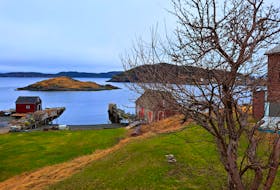And if you’re not emotionally or financially tied to the argument that’s being hotly debated in the public forum, you probably have tuned out.
So it is with the current, ongoing spat over northern shrimp.
It’s the case of the duelling reports; with the Fish Food and Allied Workers on the one hand arguing the social and economic benefits of the inshore fishery, and the Canadian Association of Prawn Producers and their factor freezer trawlers on the other, with numbers to argue that they, too, employ local people and support the local economy.
Both have statistics to support their cause.
Both say the reports being used by their other side are flawed.
The statistics and data — elements that should create clarity — are now information overload. It’s causing some folks to tune out.
But if you live and work in this province, you should care about these things; not just about the northern shrimp debate, but for the commercial fishery as a whole, and rural communities that depend on it.
Allow me to explain.
I promise, I’ll only use numbers that are important to the context of this story.
I can only hope it will make sense to you.
The first number is: 43, as in per cent.
Of all the fish landed in this province, shrimp makes up 43 per cent and snow crab makes up the other 43 per cent.
Currently, they are the most important fisheries.
The second number is: 609 — as in millions of dollars.
That was the value of shellfish in 2015 — crab and shrimp — at the point that it was taken from the boats and put in grey tubs to be carted off to the fish plant for processing.
The third number — 110 — again in millions of dollars.
That’s how much the groundfish fishery (cod, turbot, flounder) was worth at the point it was landed at the wharves.
Add in capelin, herring, mackerel, seals — and I’m not even going to mention aquaculture for the purposes of this simple lesson — and I’m hoping you’re starting to get the picture.
Here’s the final number I want you to remember: $950 million.
Shag it, let’s round it up to a neat $1 billion.
That’s the value of our fish after it’s been taken out of the grey tubs, sent through the assembly lines, frozen, packaged and exported to places like the US and Japan.
What does all of that fish mean to folks who work the boats or toil on the assembly lines at the fish plant?
It means a fairly steady income during the fishing season.
Don’t take my word for it, though.
But consider this number: 17,494.
That’s the number of people who earned a living from the fishing industry in this province in 2015 (9,334 as skippers and crew members and the rest on the processing side of the equation).
And I’m not counting the truck drivers, dockside monitors, and others who also have jobs because of the fishery.
Oil might have given us wealth and high-paying jobs, but it doesn’t match — in terms of individual, direct and secondary jobs — the work created by the fishery for rural Newfoundland and Labrador.
Another number I’d like you to remember is 83.
That’s the number of fish plants that operated in this province in 2015.
They are in places like Port aux Choix, St. Anthony, Twillingate, Fogo Island, Harbour Breton, Bonavista and other rural areas, where the only oil money that comes to town is in a handful of wallets on each turnaround.
The fishery, however, while subject to ups and downs of the economy and the Canadian dollar against the US greenback, has provided relatively stable income for folks who call these communities home.
Fish is food; and food is essential. When all else fails, people still need to eat.
The other thing I would ask each of you to consider is this — an economy cannot survive with recycled money.
Sometimes, people who live in centralized towns — towns that are fortunate enough to have built an economy on government services and civil service jobs — put up a great fight for those government jobs, but lose sight of the fact that ‘new’ money is the essential ingredient to keeping an economy thriving.
Every single pound of fish — whether it be cod, shrimp, crab, capelin or lobster —landed at a rural Newfoundland and Labrador wharf is worth a few more bucks of new money to your local economy.
We have not managed to become the manufacturing capital of the world when it comes to gadgets and gizmos that you find on the shelves at CostCo and Walmart.
But we have been pretty decent at — and could be even better at — feeding the world with our fish.
To conclude I offer two final numbers.
The first is: 900.
That’s how many people live in the Town of Port aux Choix on the Great Northern Peninsula. In this town the major industry is fishing — more particularly shrimp fishing; specifically the shrimp from Shrimp Fishing Area 6.
Port aux Choix can’t afford to take out television ads to tell how important the shrimp fishing is to them; or what they will lose if local boats can’t fish SFA6.
They don’t have the resources of the Canadian Prawn Producers Association and they don’t tap economists into the room to argue their point.
That does not mean, however, that their knowledge and experience and basic math have no value.
They know what it means to lose an important local industry. They suffered through the cod moratorium of the 1990s and their loss was significant — a lot of the younger generation left and never came back.
So they know that if they lose shrimp, it could be the final blow.
To conclude, I offer you this final number: zero.
If the boats that fish out of Port aux Choix can’t maintain their quotas in SFA6, Port aux Choix will go to zero.
Without shrimp, the 200 people who work at the local plant will have to ship out.
When those 200 people ship out, their kids will move with them and there will be need for less of everything — teachers, medical clinic staff, postal workers and others who live and work in this coastal community.
That story could be repeated in St. Anthony, Fogo and other places that are home to the plants that depend mainly on shrimp.
Port aux Choix has existed because of the fishery. Its only chance, at the moment, is shrimp.
It is essential, therefore, that fishery managers figure a way to ensure that inshore fishing boats — like the ones out of Port aux Choix — can maintain sufficient quotas from SFA6 to keep the local plants and economies running.
And that is, quite simply, based on my calculations, the bottom line.
Until next week: Over and Out.
Fishing — by the numbers
It can make your eyes glaze over, I’ll grant you that.
STORY CONTINUES BELOW THESE SALTWIRE VIDEOS







